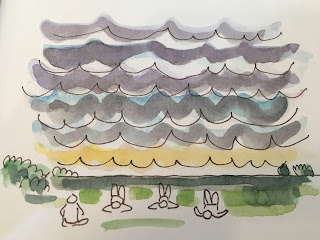 |
| Family Nature Journal: A Curriculum |
"You may say you have no nature around you where you live. Or perhaps you don't have time to go looking for nature. Or maybe you aren't sure where to begin. I think one easy and fun way to start, no matter where you live, is to simply observe the sky above. It is always there." – Clare Walker Leslie, from Drawn to Nature
After attending a very enlightening information session put on by Sustain Dane's Outdoor Learning Network, one thing that became clear, as it has in the past, is that people need to connect with nature. But how we do that is bound to be as varying and dynamic as people themselves, which is to say infinitely. In a way then we are all potential curriculum builders for our own nature projects, our hikes, our gardening, our hunting and fishing, our learning, our art and our wonder. The Family Nature Journal: A Curriculum, is meant to be a project in motion, a set of thoughts and observations that might have just as much a tendency to look backwards as forwards, and, if fortunate, always looking right now directly up into the sky, for that would mean that today has been a good day, somewhere, somehow, outside.
We are finally now in the full-on evidence stage of realizing that people, no doubt kids especially, need nature connection. There is no need to try to go through the entirety of all that in this blog slot – in a way, it is complete common sense once we give ourselves even a moment to think about it – but it is important it seems to realize that in order for that connection to happen, it might not necessarily happen for free, but in many cases needs to be sought out intentionally, even earned. We practice many things to become good at: reading, writing, arithmetic, music, sports, video games. It shouldn't surprise us at all that a connection to nature has similarities. To purposefully prompt children to get outside and take a walk or check out the ducks at the park, well, it takes some prompting and it takes sometimes some good but firm arguments for those days when the response is "no way." To consider the simple measure of a rule that goes something like this, "one hour of screen equals one hour outside," can only work if the second half of the equation has follow through day in and day out. It's very possible, hopefully likely, that once this system becomes part of daily life, the child will in fact begin to seek out that hour on their own. I have seen it happen with my own eyes.
The family nature journal will need an initial prompting, a commitment. A simple daily check off sheet could be a start, art projects, writing projects, or even a family centered blog. If none of this practical concrete 'achievement' is necessary, that is great in a way, because it means all it takes is some verbal prompting and that is that. But for other learners and 'experiencers,' something created and concrete might be just the thing. A great and simple start is right where Clare Walker Leslie
begins her wonderful book of journaling where she takes down the the note, "I began noticing the sky when out in Minnesota teaching students to observe local land. We were on our backs watching billowing rolls of clouds filling the entire sky. No one knew what they were. Later, we were informed they were mammatus clouds – clouds of high disturbance."
"Clouds of high disturbance" is a writing instructor's dream and one that could easily become a stop-off point for a poem or any other kind of written observation. The drawing here is simple and engaging (never as easy as it looks when it comes from a great artist). Free and easy is the key to begin. I recently had the opportunity to take a nature art journaling course at the UW Arboretum and was very quickly reminded that my ambition simply didn't match up to my ability and I had to scale back my attempts at drawing nature from intricate and accurate to light and whimsical. In twenty minutes I could create a postcard size drawing from nature and was very satisfied with the low pressure process of pencil or watercolors. The key is, the real point of entry, is that the 20 minute drawing is time spent not only outside, but time of connection that easily rivals (and we hope surpasses) anything experienced on screen or indoors. Replacing artificial images with natural images is really an enormous part of the outdoor learning movement.
Curriculum option 1: buy some water color postcards at the art store, along with whatever art tools necessary, and draw a 20 minute picture from nature on the front. On the back, write a journal entry. If an interesting phrase pops up, write a poem of any length along the side or at the bottom. Hand it to a parent or send it to a relative.


No comments:
Post a Comment